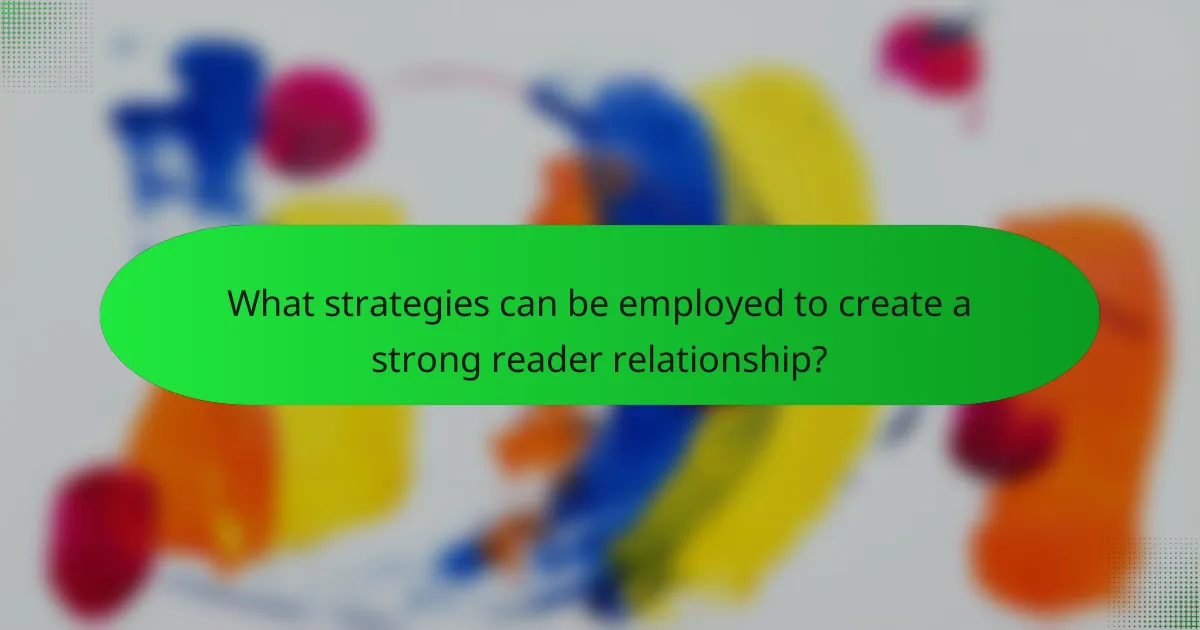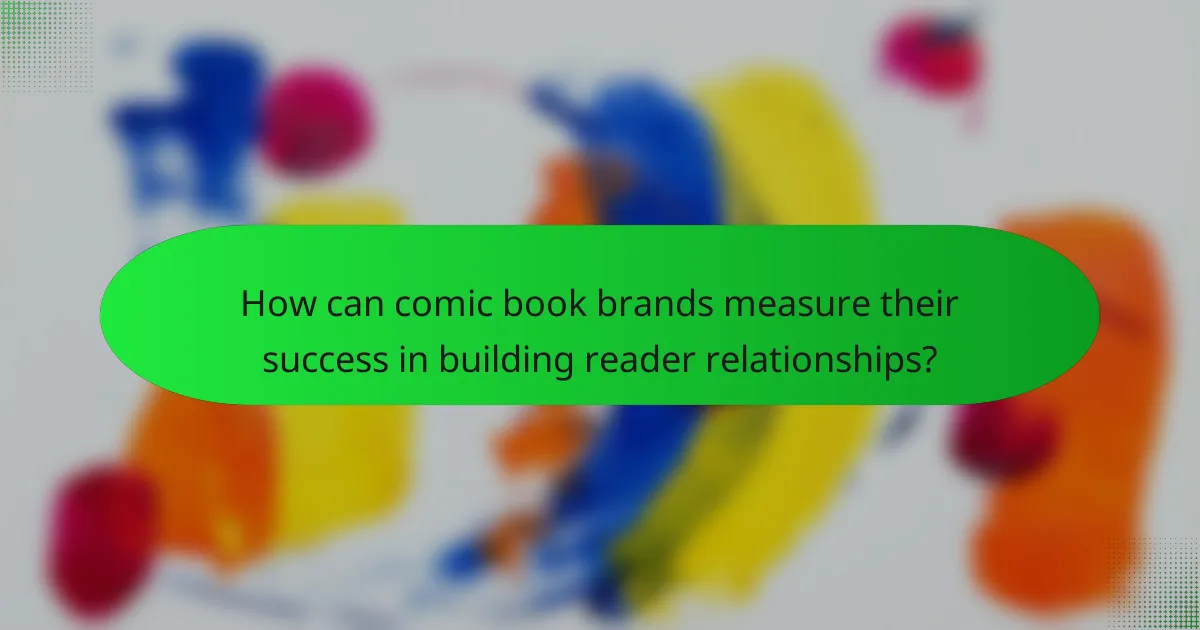Building a comic book brand involves creating a unique identity that connects with readers through distinctive characters, engaging storylines, and a consistent visual style. Successful brands, such as Marvel and DC, demonstrate the importance of maintaining a cohesive narrative across various media while fostering community engagement through social media. Strategies for enhancing reader relationships include interactive content, regular communication, and exclusive offerings. Success can be measured through engagement metrics, sales data, and reader feedback, providing insights into brand loyalty and audience satisfaction. This article outlines effective strategies for establishing and nurturing strong reader connections within the comic book industry.

What does it mean to build a comic book brand?
Building a comic book brand means creating a unique identity that resonates with readers. This involves developing distinctive characters, engaging storylines, and a consistent visual style. A strong brand fosters loyalty and recognition among audiences. Successful comic book brands, like Marvel and DC, exemplify this through their iconic characters and expansive universes. They maintain a cohesive brand narrative across various media, including films and merchandise. Additionally, community engagement through social media enhances reader relationships. Ultimately, building a comic book brand is about establishing a lasting connection with fans through quality content and consistent branding efforts.
How can a comic book brand effectively connect with readers?
A comic book brand can effectively connect with readers by engaging them through storytelling and community involvement. Strong narratives resonate with readers and encourage emotional investment. Interactive platforms, such as social media, allow for direct communication and feedback. Hosting events like conventions fosters a sense of community among fans. Collaborating with artists and writers enhances authenticity and connection. Surveys and polls can gather reader preferences, tailoring content to their interests. Brands that showcase reader art or fan fiction create a participatory culture. These strategies have been shown to increase reader loyalty and brand recognition.
What are the essential elements of a strong comic book brand identity?
A strong comic book brand identity consists of distinct visual style, compelling characters, and engaging storytelling. The visual style includes unique art and color palettes that resonate with the target audience. Compelling characters are memorable and relatable, often featuring clear motivations and development arcs. Engaging storytelling weaves intricate plots that captivate readers and encourage emotional investment. Consistent branding across various media platforms reinforces recognition and loyalty. Market research indicates that brands with clear identities enjoy higher reader retention and sales. For example, Marvel and DC Comics leverage their iconic characters and visual styles to maintain strong market presence.
How does storytelling influence brand development in comics?
Storytelling significantly influences brand development in comics by creating emotional connections with readers. Engaging narratives help to establish a brand’s identity and values. Strong characters and plots foster loyalty among fans. This connection encourages readers to invest in the brand long-term. For instance, iconic comic series like “Batman” and “Spider-Man” have built extensive fanbases through compelling storytelling. These stories resonate with audiences, enhancing brand recognition and trust. Additionally, well-crafted narratives can lead to merchandise and adaptations, further expanding the brand’s reach. Overall, storytelling is essential for cultivating a successful comic book brand.
Why is reader relationship important for a comic book brand?
Reader relationship is crucial for a comic book brand because it fosters loyalty and engagement. A strong relationship encourages readers to invest emotionally in characters and storylines. This emotional investment leads to repeat purchases and word-of-mouth recommendations. According to a survey by the Comic Book Industry Alliance, 70% of readers prefer brands that interact with them regularly. Engaging with readers through social media and events enhances their connection to the brand. This connection can translate into a dedicated fanbase that supports the brand’s growth. Ultimately, a positive reader relationship drives sales and long-term success for comic book brands.
What impact does reader engagement have on brand loyalty?
Reader engagement significantly enhances brand loyalty. Engaged readers are more likely to connect emotionally with a brand. This emotional connection fosters trust and encourages repeat interactions. According to a study by Gallup, highly engaged customers are 23% more likely to exhibit loyalty behaviors. These behaviors include purchasing more frequently and recommending the brand to others. In the comic book industry, strong reader engagement can lead to a dedicated fan base. Fans often share their enthusiasm on social media, amplifying brand visibility. This organic promotion further solidifies brand loyalty among existing and potential readers.
How can feedback from readers shape a comic book brand?
Feedback from readers can significantly shape a comic book brand. It informs creators about audience preferences and expectations. This input helps refine storylines and character development. For instance, positive reviews can validate successful themes. Conversely, negative feedback highlights areas needing improvement. Brands that actively engage with readers often see increased loyalty. Reader surveys and social media interactions provide direct insights. Brands like Image Comics have adapted their offerings based on reader responses. This responsiveness fosters a community around the brand, enhancing its reputation and reach.

What strategies can be employed to create a strong reader relationship?
To create a strong reader relationship, engage them through interactive content. Interactive content includes polls, quizzes, and feedback opportunities. This approach fosters a sense of community among readers. Regularly updating readers with newsletters enhances their connection to the brand. Consistent communication keeps readers informed and valued. Additionally, responding to reader comments builds trust and loyalty. Offering exclusive content to subscribers can deepen their engagement. Utilizing social media platforms to share behind-the-scenes insights also strengthens the relationship. These strategies collectively enhance reader loyalty and brand affinity.
How can social media enhance reader engagement for comic book brands?
Social media can enhance reader engagement for comic book brands by facilitating direct communication with fans. It allows brands to share updates, sneak peeks, and behind-the-scenes content. This transparency builds trust and excitement among readers. Interactive features, such as polls and Q&A sessions, encourage audience participation. Brands can also create communities where fans discuss their favorite stories and characters. According to a 2020 survey, 78% of comic book readers engage with brands on social media. This engagement can lead to increased loyalty and sales. By utilizing targeted advertising, comic book brands can reach specific demographics effectively. Overall, social media serves as a vital tool for fostering a strong reader-brand relationship.
What platforms are most effective for comic book brands to connect with their audience?
Social media platforms are most effective for comic book brands to connect with their audience. Platforms like Instagram, Twitter, and Facebook allow for direct interaction. These platforms support visual content, which is crucial for comic book promotion. Instagram’s focus on imagery helps showcase artwork and character designs. Twitter enables real-time engagement and updates about new releases. Facebook provides community-building features through groups and events. Additionally, platforms like TikTok are emerging as effective for reaching younger audiences. Studies show that 70% of comic readers engage with brands on social media. This proves that these platforms are vital for fostering reader relationships.
How should comic book brands approach content creation for social media?
Comic book brands should approach content creation for social media by focusing on engagement and community building. They need to share behind-the-scenes content to connect with fans. This includes sketches, character designs, and creator insights. Brands should also leverage storytelling through posts and videos. Engaging with followers through polls and Q&A sessions can foster interaction. Regularly posting updates about new releases keeps the audience informed. Collaborating with artists and influencers can expand reach. According to a 2021 survey, 70% of comic readers prefer brands that actively engage on social media. This demonstrates the importance of a strategic social media presence.
What role does community building play in comic book branding?
Community building plays a crucial role in comic book branding by fostering reader loyalty and engagement. It creates a sense of belonging among fans. Engaged communities often lead to increased word-of-mouth promotion. This can significantly enhance visibility and sales for comic book brands. Furthermore, community interaction provides valuable feedback for creators. This feedback can guide future storylines and character development. Events like comic conventions and online forums strengthen these community ties. Successful brands often leverage social media to connect with their audience. This connection can create a dedicated fan base that supports the brand long-term.
How can comic book brands foster a sense of community among readers?
Comic book brands can foster a sense of community among readers by creating interactive platforms for engagement. These platforms can include social media groups dedicated to discussions about storylines and characters. Hosting events such as comic book conventions allows readers to connect in person. Brands can also encourage fan art submissions, showcasing reader creativity. Collaborating with local comic shops can create community events that draw in local readers. Regularly featuring reader feedback in publications builds a sense of ownership among fans. Additionally, offering exclusive content for community members can incentivize participation. By implementing these strategies, comic book brands strengthen reader connections and enhance community feeling.
What are the best practices for hosting events or conventions to strengthen reader relationships?
Engaging readers through events or conventions is essential for building strong relationships. First, create interactive experiences that allow readers to participate actively. Workshops, Q&A sessions, and panels foster engagement. Second, promote networking opportunities among attendees. This encourages community building and connections. Third, provide exclusive content or merchandise. Limited editions or sneak peeks create excitement and loyalty. Fourth, gather feedback during the event. This shows readers their opinions matter and helps improve future events. Lastly, follow up with attendees post-event. Sending thank-you emails or surveys keeps the conversation going and strengthens the relationship. These practices have been shown to enhance reader loyalty and community engagement in the comic book industry.

How can comic book brands measure their success in building reader relationships?
Comic book brands can measure their success in building reader relationships through reader engagement metrics. These metrics include social media interactions, such as likes, shares, and comments on posts. Additionally, brands can analyze sales data to determine how well specific titles resonate with their audience. Surveys and feedback forms provide direct insights into reader satisfaction and preferences. Tracking subscription rates for digital platforms also indicates loyalty and ongoing interest. Events like signings and conventions can be assessed for attendance and reader interactions. Finally, brand mentions in online forums and communities reflect the brand’s presence and reputation among readers.
What metrics should be used to evaluate reader engagement?
Metrics to evaluate reader engagement include page views, time on page, and bounce rate. Page views indicate how many times content is accessed. Time on page measures how long readers stay engaged with the material. A high bounce rate suggests that readers leave quickly without further interaction. Additionally, social shares and comments reflect reader interaction and interest. Email open rates can also signal engagement levels for newsletters or updates. Tracking these metrics helps assess the effectiveness of content in maintaining reader interest and building relationships.
How can qualitative feedback enhance understanding of reader satisfaction?
Qualitative feedback enhances understanding of reader satisfaction by providing in-depth insights into reader preferences. This feedback reveals emotions and motivations that quantitative data cannot capture. For example, reader comments can highlight specific storytelling elements they enjoyed or disliked. Such insights allow creators to identify trends in reader experiences. Analyzing this feedback can lead to improved content that resonates more with the audience. Research indicates that 70% of consumers prefer personalized experiences based on their feedback. Therefore, incorporating qualitative feedback can significantly enhance reader engagement and loyalty.
What are some common challenges in building a comic book brand?
Common challenges in building a comic book brand include market saturation, audience engagement, and distribution issues. The comic book market has many established players, making it hard for new brands to stand out. Engaging readers consistently is vital for brand loyalty. Many new creators struggle to maintain a connection with their audience over time. Distribution can also be problematic, as getting comics into stores and online platforms is competitive. Additionally, financial constraints can limit marketing efforts. Quality control is essential, as subpar artwork or writing can damage a brand’s reputation. Lastly, evolving reader preferences pose a challenge, requiring brands to adapt continuously.
How can brands overcome obstacles related to audience reach?
Brands can overcome obstacles related to audience reach by utilizing targeted marketing strategies. These strategies include identifying specific audience segments. Brands should leverage social media platforms to engage with these segments. Research indicates that 73% of marketers believe that social media has been effective for their businesses. Collaborating with influencers can also expand reach significantly. Influencer partnerships can increase brand visibility and credibility. Additionally, brands should invest in content marketing to provide value to potential readers. This approach builds trust and encourages audience engagement. Data shows that content marketing generates three times more leads than traditional marketing.
What strategies can be implemented to address negative feedback from readers?
Acknowledge the feedback directly and promptly. This shows readers that their opinions matter. Responding in a timely manner can enhance trust. Offer solutions or changes based on the feedback received. This demonstrates a commitment to improvement. Encourage open dialogue to foster a sense of community. Engaging with readers can mitigate negativity. Use feedback to refine content and enhance quality. This approach can lead to better reader satisfaction. Implementing these strategies can strengthen the relationship with readers.
What practical tips can comic book brands follow to strengthen reader relationships?
Comic book brands can strengthen reader relationships by engaging directly with their audience. They should utilize social media platforms to interact and respond to reader feedback. Hosting events, such as comic book signings or conventions, can create personal connections. Offering exclusive content or behind-the-scenes insights can enhance reader loyalty. Creating loyalty programs rewards dedicated fans and encourages repeat purchases. Collaborating with popular creators can attract new readers and retain existing ones. Regularly conducting surveys helps brands understand reader preferences and improve offerings. These strategies have been shown to increase reader satisfaction and brand loyalty in various industries.
Building a comic book brand involves creating a unique identity that resonates with readers through distinctive characters, engaging storylines, and a consistent visual style. This article outlines strategies for effectively connecting with readers, emphasizing the importance of storytelling, community engagement, and reader relationships. Key elements of a strong brand identity, the impact of reader engagement on loyalty, and methods for measuring success will be discussed. Additionally, practical tips for fostering reader relationships and overcoming challenges in audience reach will be provided, highlighting the significance of feedback and interaction in brand development.